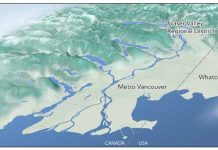METRO Vancouver is continuing an Air Quality Advisory for Metro Vancouver and the Fraser Valley because of high concentrations of fine particulate matter that are expected to persist for several days. Air quality continues to be affected by the current weather pattern over the B.C. Coast, which has caused outflow winds to transport smoke from wildfires burning in the BC Interior towards our region.
Concentrations of ground-level ozone are also now expected to reach advisory levels in the eastern portions of Metro Vancouver and the Fraser Valley due to hot weather conditions.
Ground-level ozone is not emitted directly into the air. It is formed when nitrogen oxides (pollutants emitted when fuels are burned) and volatile organic compounds (emitted from solvents) react in the air in the presence of sunlight. The highest levels of ground-level ozone are generally observed between mid-afternoon and early evening on summer days.
Fine particulate matter, also known as PM2.5, refers to airborne solid or liquid droplets with a diameter of 2.5 micrometres (µm) or less. PM2.5 can easily penetrate indoors because of their small size.
Avoid strenuous outdoor activities, particularly during mid-afternoon and early evening when ozone levels are highest. Exposure to ozone and fine particulate matter is particularly a concern for infants, the elderly and those who have underlying medical conditions such as lung disease, heart disease, diabetes or asthma. If you are experiencing symptoms such as chest discomfort, shortness of breath, coughing or wheezing, follow the advice of your healthcare provider. As we are in the summer season with warm temperatures, it is also important to stay cool and hydrated. Indoor spaces with air conditioning may offer relief from both heat and air pollution.
This advisory is expected to continue until there is a change in the current weather.
Metro Vancouver works in cooperation with Environment and Climate Change Canada, Fraser Valley Regional District and B.C. Ministry of Environment to look after air quality.
Information about real-time air quality readings for Metro Vancouver and Fraser Valley communities and potential health impacts can be found at www.airmap.ca and www2.gov.bc.ca/gov/content/
BACKGROUNDER
What is ground-level ozone?
Ground-level ozone is not emitted directly into the air. It is formed when nitrogen oxides (pollutants emitted when fuels are burned) and volatile organic compounds (emitted from solvents) react in the air in the presence of sunlight. The highest levels of ground-level ozone are generally observed between mid-afternoon and early evening on summer days. A brief video explaining how ground-level ozone is formed can be found at player.vimeo.com/video/
What is fine particulate matter?
Fine particulate matter, also known as PM2.5, refers to airborne solid or liquid droplets with a diameter of 2.5 micrometres (µm) or less. PM2.5 can easily penetrate indoors because of their small size. PM2.5 concentrations tend to be highest around busy roads, industrial operations, major ports as well as areas with residential wood burning.
Tips to reduce your personal health risk
- Stay cool and drink plenty of water.
- Use symptom management medications, such as inhalers, if needed.
- Continue to manage medical conditions such as asthma, chronic respiratory disease and heart failure. If symptoms continue to be bothersome, seek medical attention.
- Maintaining good overall health is a good way to prevent health effects resulting from short-term exposure to air pollution.
And especially for persons with chronic underlying medical conditions:
- Avoid strenuous activity outdoors and stay in cool, air-conditioned environments, especially during the afternoon and early evening when ozone levels are highest.
- Reduce indoor sources of pollution such as smoking and vacuuming, and run an air cleaner. Some room air cleaners, such as HEPA filters, can help reduce indoor particulate levels provided they are the right size for your home and filters are changed regularly.
- Consider taking shelter in air-conditioned buildings which have large indoor volumes and limited entry of outdoor air.
Voluntary emission reduction actions
Reducing sources of fine particulates throughout Metro Vancouver and the Fraser Valley will be beneficial to air quality. Actions people can take:
- Minimize the use of diesel powered equipment.
- Consider taking transit or carpooling rather than driving to your destination.
- Follow local regulations for recreational fires. Avoid lighting a fire where possible.
Additional Information
- Fine particulates are emitted from transportation sources, non-road engines, heating and burning.
- Fine particulate levels are compared to medium-term (24-hour) objectives.
- Nitrogen oxides are emitted from fuel combustion processes including transportation, boilers, and building heating.
- Volatile organic compounds commonly arise from burning fossil fuels, solvent evaporation (including paint, varnishes and thinners), fuel refining and storage, fuel refilling, and agricultural activities as well as natural sources such as vegetation.
- Ozone levels are compared to short-term (1-hour) and medium-term (8-hour) objectives. The short-term objective measures the peak/highest concentration and the medium-term objective represents the average over the period of the day when levels are generally elevated.
Under provincial legislation, Metro Vancouver is responsible for monitoring air quality, controlling industrial, commercial and some residential emissions, creating long-term plans, and conducting emission inventories for the Metro Vancouver region.
To help reduce air emissions throughout the Lower Mainland, Metro Vancouver works cooperatively with Fraser Valley Regional District, the B.C. Ministry of Environment, Environment Canada and other agencies to develop and implement emission reduction programs for businesses and local residents. Further information about air quality programs in the region can be found on Metro Vancouver’s website.










